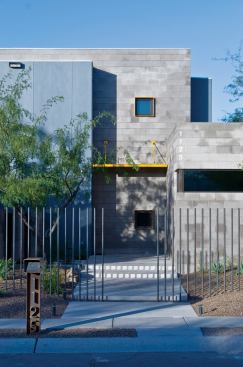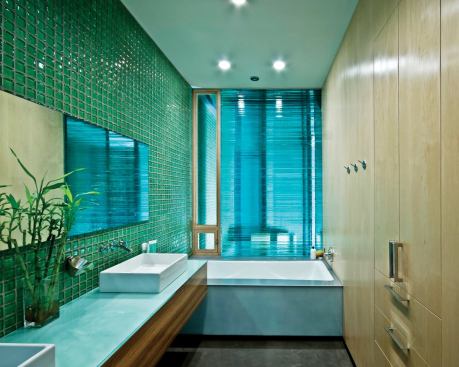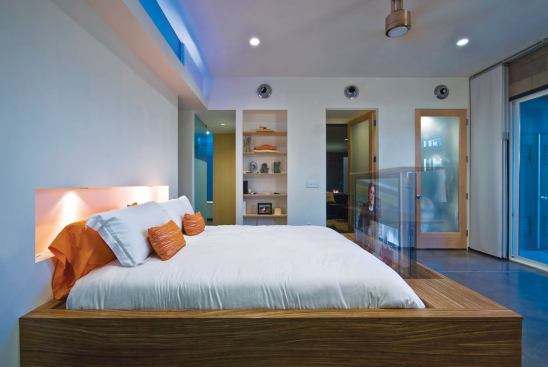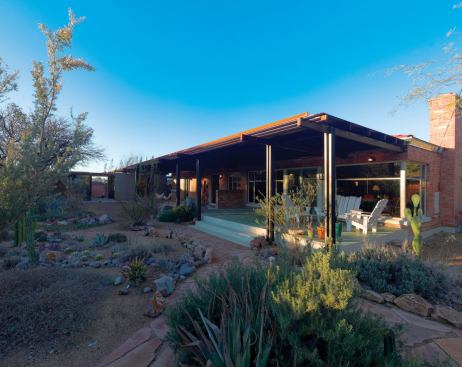Liam Frederick
In 2007, Repp renovated and added onto the house he designed for…
Architect and builder Page Repp Jr. has always chosen the unexpected route. The son and grandson of construction industry veterans, he could have followed directly in their footsteps. Instead, he opted to attend architecture school at The University of Arizona. Before graduating in 1998, he got his contractor’s license and built his thesis project: a modern home for himself in Tucson, Ariz. And he started his own design/build company in Tucson rather than going to work for another firm, as most architecture school graduates do.
You see, Repp is all about creating his own niche. “You’ve got to distinguish yourself as the best person to use,” he says. “You’ve got to push yourself to the front.” Design/build appeals to him, he adds, because “there’s a single point of control from start to finish.” About 70 percent of Repp Design + Construction’s work is design/build, and the company also serves as a general contractor for projects by other architects. Custom residential makes up the majority of its work, although it also builds infill multiunit housing for developer clients, including Dreamspace, a partnership between Repp and fellow Tucsonans Luis Ibarra and Teresa Rosano of Ibarra Rosano Design Architects.
Repp and his team have always focused on energy-efficient design and building, which has positioned them well throughout the recession. They particularly like using masonry building systems, concrete, and steel, which all partner well with desert climate conditions. “We’ve been very fortunate,” says Rick McLain, an architect who became a partner at Repp Design + Construction in 2008. “We’re able to offer a niche product, and the values and core principles we espouse are now more prevalent.” Although the Arizona housing market was decimated by the economic difficulties of the past couple years, the company has remained relatively busy. It’s currently working on three custom homes (all design/ build) and has four more in design.
As McLain points out, its experience in building green, reasonably sized homes aligns nicely with today’s tastes. Current custom projects range in size from 1,200 square feet to 4,000 square feet and incorporate such sustainable features as passive solar design and rainwater harvesting. “We encourage urban infill to reduce occupants’ driving distances and try to reuse existing building stock to reduce landfill demolition waste,” he explains.
But their most ambitious green project yet is the renovation of a downtown Tucson commercial building they recently bought to use as a new office space. “This is quite a big step for us,” Repp admits. “Definitely a nerve-racking step.” At 4,400 square feet, the building is more than three times as large as Repp Design + Construction’s existing office. The company is working on an exterior remodel, as well as adding a 1,100-square-foot shop. (Initially, the plan is to rent out part of the office space to a tenant.) Solar panels, an energy monitoring system, xeriscaping, and rainwater harvesting will help the project along to a projected LEED Gold or Silver rating. “It’ll be our own demonstration laboratory,” McLain says of the building’s many green technologies.
In the shop, he, Repp, and their staff will be able to create custom building components, such as light fixtures, cabinetry, and staircases. They’ve invested in a few CNC (computer numerical controlled) machines that will cut down on labor and make these components less expensive. “This way we can design and build things no one else can compete with,” Repp explains. “If we can provide incredibly designed, unique pieces that cost less than the stuff at The Home Depot, we’ll have a competitive advantage.” Ideally, he continues, they could start fabricating items for other architects and even have their own product line.
The office project is slated for completion by the end of January. Repp hopes the experience of designing and building it will help the company attract more nonresidential clients. “I’m trying to make it so that we can do more complex projects,” he says. “You want to challenge yourself and continue to grow. I love building smaller homes, but I definitely look forward to the opportunity provided by larger projects to utilize new technologies. On a larger project, economies of scale allow you to try out new things, whereas on a smaller project the budget is sometimes just too tight to allow flexibility with new systems.” The Repp Design + Construction staff includes two designers with extensive experience in commercial architecture, Stacy Burnett and Jenni Van Brocklin. Their backgrounds complement that of McLain, who developed skills in CNC programming while getting his graduate degree in architecture at MIT. “We’re trying to build on the skills of our key people,” Repp says.
His derring-do is accompanied by a hint of anxiety; Repp is well-aware of the financial risk he’s taking by investing in a first-class workspace and top people during a period of economic turmoil. He and his colleagues have thrown themselves into the office project, doing all they can to make their “$850,000 gamble,” as Repp dryly describes it, pay for itself in spades. “This building is basically our advertising budget for the next 20 years,” he says.
The company already boasts a great reputation in and around Tucson. Last year it won a Southern Arizona Smart Inspiring Enterprise (SASIE) Award from the Arizona Small Business Association, and in 2008 it received a Southern Arizona Better Business Bureau Ethics Award. Repp has achieved success so far by following his own instincts, and there seems no reason to stop doing so now. The new office space is a linchpin of the company’s plan for the future. “The market itself has had a fundamental change,” he says. “If we didn’t make this kind of jump forward, we would have remained smaller. We’ll still be small, but we’ll be better able to compete.”
Repp Design + Construction, Tucson, Ariz.
www.repp-inc.com
Type of business: Design/build
Years in business: 14
Employees: 8
Annual revenue: $2 million
Average number of projects per year: 9
Project type breakdown—remodeling vs. new construction: 20 percent vs. 80 percent
Project type breakdown—residential vs. commercial: 80 percent vs. 20 percent








